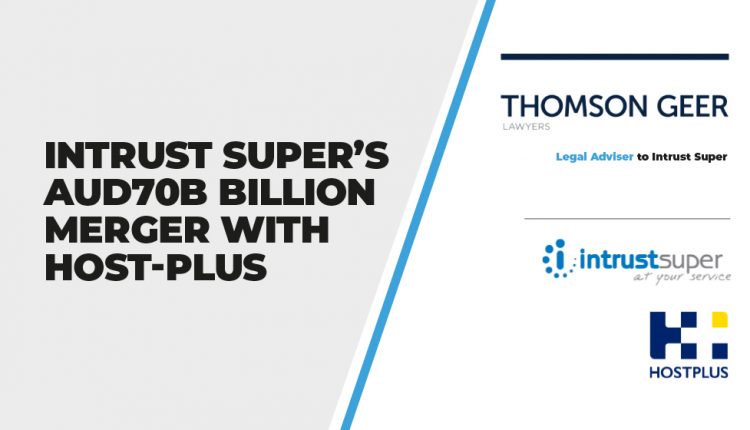Intrust Super’s AUD70B Billion Merger With Host-Plus
Following Thomson Geer's work on the merger between Intrust and Hostplus, we speak exclusively with Scott Charaneka, Head of Superannuation and Wealth Management at THOMSON GEER about the work and the deal.
Thomson Geer recently advised superannuation fund Intrust Super on its merger with fellow super fund Hostplus.
Hostplus and InTrust Super signed a successor fund transfer deed, bringing the two industry-leading funds together to create a AUD70 billion national superannuation fund. A target date of 26 November 2021 has been set for the merger.
Intrust Super is heavily involved in the hospitality, clubs, tourism and retail sectors, counting over 90,000 members, 25,000 contributing employers and about $3 billion in assets under management.
Hostplus is based in the hospitality, tourism, recreation and sports sectors with 1.25 million members, 233,000 contributing employers and $66 billion in funds under management. Hostplus is one of the largest and best performing superannuation funds in Australia.
The Thomson Geer team was led by superannuation and wealth management partners Scott Charaneka and Stanley Drummond and assisted by lawyers Holly Marchant and Ashley Zhang.
Here Scott Charaneka, Head of Superannuation and Wealth Management at THOMSON GEER tells us more about the merger and the work undertaken.
Please tell us more about your involvement in this deal.
We have acted on over 60 larger fund mergers over the past decade, but the number of merger instructions has definitely increased over the past 12 months.
InTrust initially sought our advice on the steps involved in a fund merger, which then evolved into project planning and then drafting of the relevant transaction documents. We also worked closely with the board to ensure that their obligations were properly covered.
Another key dimension was to reduce the execution risk by ensuring that the transaction parties post-merger expectations were aligned.
Did any challenges arise along the way?
Super fund trustees (and their directors) are subject to a professional fiduciary standard of care, skill and diligence. Demonstrating how the trustee and its directors have met this standard requires considerable work, starting with the proper construction of the data rooms.
The two other key issues were regulator oversight (which historically has not been an issue in these types of transactions) and developing the post-merger organisational chart.
How did you navigate them with your team?
We do operate as a team, so everyone has a key area of focus – which eventually leads to the production of the board paper attaching to our sign-off letter.
Working with our regulators requires considerable experience; especially to ensure that the messaging remains clear.
Addressing the concerns of employees must be dealt with sensitivity and detailed planning.
What are clients’ main concerns when entering a significant merger like this?
That something may get missed! These are large corporate transactions. There are many moving parts and you need to cover them all. Matters such as equivalency of members’ rights, mandated and non-mandated member communications, life insurance contracts, unlisted investment valuations, direct and indirect taxes, staff employment offers, treatment of operational reserves, residual assets, post-transaction date expenses and litigation should require close attention.
Are there any potential issues unique to mergers between superannuation funds?
Our statutory framework imposes a very high standard of conduct for the client and its directors. The standard is higher than in other areas of corporate work. A failure to meet the standard can give rise to a statutory claim for damages.
How do you work with your clients to ensure these issues are handled and their concerns are addressed?
We start with a briefing to explain how they may be held accountable in the event of a due diligence “fail”. We then work with our client to construct a proper deal team and governance model. Usually we would have daily contact to make sure the project stays on track.




